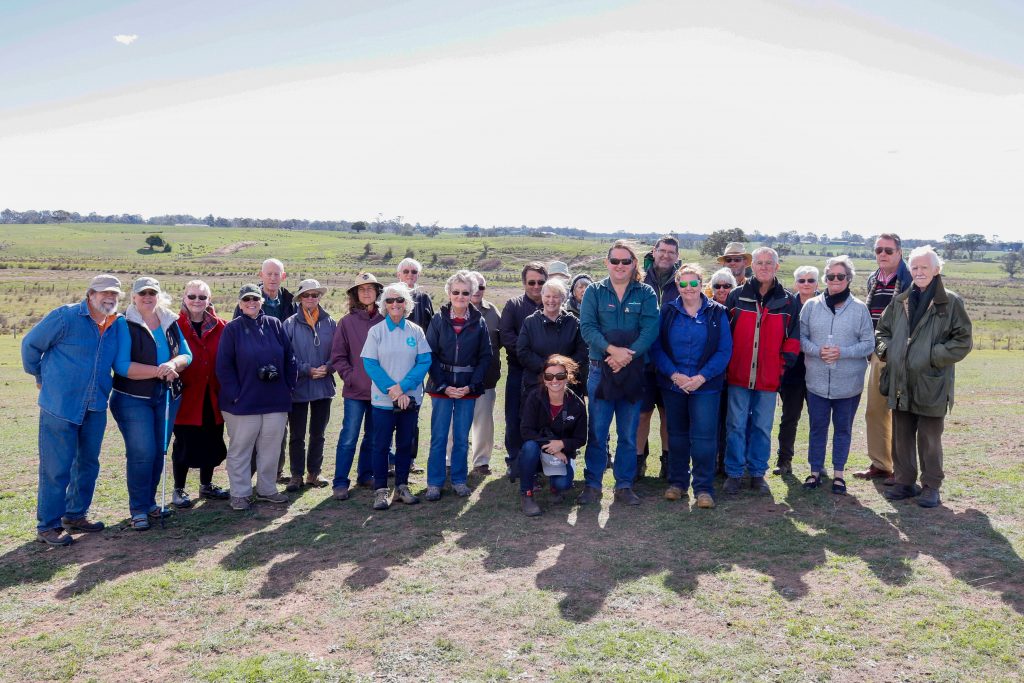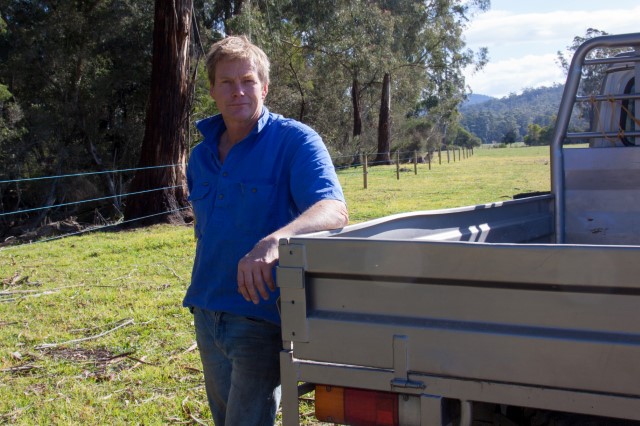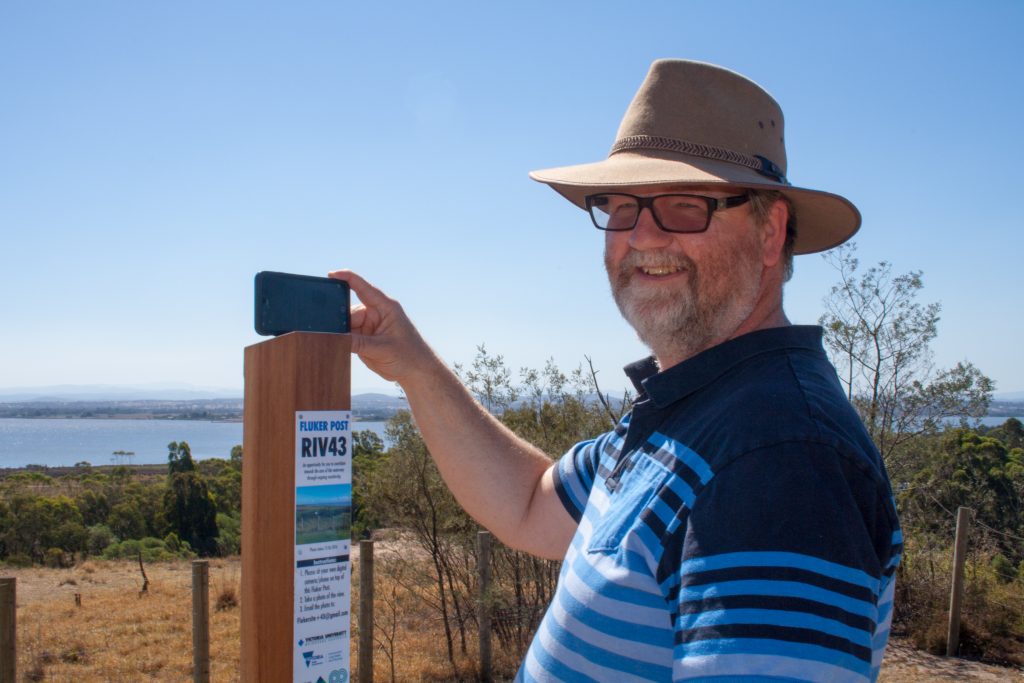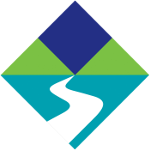
The East Gippsland Catchment Management Authority (EGCMA) hosted members from the DELWP Our Catchments, Our Communities (OCOC) team recently when they visited the region to learn about the progress of two projects funded by the Victorian Government’s $222 million investment to improve the health of the state’s waterways and catchments.
The EGCMA is working together with landholders, Gunaikurnai Land and Water Aboriginal Corporation (GLaWAC), community and partner agencies in the Swifts Creek / Ensay area to deliver a coordinated approach to looking after the Tambo catchment. The works have included fencing off stock access to the Tambo River, controlling weeds and planting native seedlings to encourage revegetation.
Also, at Skull Creek near Lindenow on the Red Gum Plains, Greening Australia is working closely with ten landholders to exclude stock from the creek, control rabbits and plant native seedlings. This project involves GLaWAC who have undertaken a cultural heritage survey on the site while their NRM crew are helping to deliver the weed control and planting. Lindenow and Lindenow South Primary schools have also been regular visitors with multiple excursions to help with revegetation and to learn about the cultural and environmental importance of the waterway.
Luke Murphy from DELWP said “It’s great to see so many community members involved in the projects. It’s nice to be able to visit the region and see the funds put to good use.”

Wetlands are more than just swamps, they serve an important ecological function and are important places for Traditional Owners.
That was the takeaway at the recent Wonders of the Wetlands tour, led by the EGCMA in conjunction with Greening Australia and the Lower Tambo Landcare Group.
Attendees had the opportunity to travel to sites along the lower Tambo to see the progress of works being undertaken by Greening Australia. They learned about the environmental and cultural importance of the Twin Rivers, while Birdlife Australia’s Deb Sullivan discussed the migratory birds who visit the Gippsland Lakes each year.
The EGCMA would like to thank the community members, landholders and partner organisations who helped make this day such a success.
Project sites visited have been funded by the Victorian State Government as part of $222 million committed to improving the health of waterways and catchments in Victoria.

The Gunaikurnai Land and Waters Aboriginal Corporation (GLaWAC) NRM Crew have been working along the banks of the Tambo River, controlling weeds between Battens Landing and Stephenson Bridge.
Working in partnership with the East Gippsland Catchment Management Authority (EGCMA), the works will improve public recreational access to the well-known swimming spots and complement revegetation works being undertaken in the area.
These works are part of a coordinated effort to improve the health of the Tambo River, together with public access and amenity from Swifts Creek downstream to the mouth of the river.
“Our NRM team are proud to be working on country in partnership with EGCMA” said Nigel Pearce, NRM Manager at GLaWAC.
“The Water Plan for Victoria seeks greater involvement of Traditional Owners and recreational users in the management of our rivers.” said the EGCMA CEO, Graeme Dear. “Our strong relationship with GLaWAC provides opportunities to build and share skills and cultural knowledge.”
The project is funded by the Victorian State Government as part of $222 million committed to improving the health of waterways and catchments in Victoria.
East Gippsland is known for it’s beautiful rivers and waterways from Mallacoota to Bairnsdale. Funding through the Victorian Government’s Regional Riparian Action Plan (RRAP) has enabled the Authority to work in partnership with landholders, community groups and traditional owners to enhance recreational fishing, maintain sites of cultural significance and reduce impacts from stock grazing. Some examples are described below.
Landholders
 On Tonghi Creek (flowing into the Cann River), landholder Chris Nixon has recently completed works on his property. Upgrading fences and installing water troughs will keep stock off the creek and provide an alternative water supply. These measures will improve water quality and support the regeneration of native plants improving the health of Tonghi creek.
On Tonghi Creek (flowing into the Cann River), landholder Chris Nixon has recently completed works on his property. Upgrading fences and installing water troughs will keep stock off the creek and provide an alternative water supply. These measures will improve water quality and support the regeneration of native plants improving the health of Tonghi creek.
Partners
 GLaWAC’s natural resource management crew provide services including fencing, weed control, growing seedlings, revegetation and cultural awareness training in Gippsland. Recently the NRM crew have been working to improve public access points to the well known fishing spots at the mouth of the Tambo River. These works are part of a coordinated effort to improve the access points and health of the Tambo River where many people like to visit.
GLaWAC’s natural resource management crew provide services including fencing, weed control, growing seedlings, revegetation and cultural awareness training in Gippsland. Recently the NRM crew have been working to improve public access points to the well known fishing spots at the mouth of the Tambo River. These works are part of a coordinated effort to improve the access points and health of the Tambo River where many people like to visit.
Community
 The Twin Rivers Community Group are currently improving public access points at five popular fishing sites on the Tambo River around Swan Reach. Funded through the RRAP Angling Grants, the project will make significant contributions to restoring and maintaining the health of the Tambo River, improving recreational fishing access and re-establishing vegetation along the river.
The Twin Rivers Community Group are currently improving public access points at five popular fishing sites on the Tambo River around Swan Reach. Funded through the RRAP Angling Grants, the project will make significant contributions to restoring and maintaining the health of the Tambo River, improving recreational fishing access and re-establishing vegetation along the river.

Citizen science in East Gippsland is now as easy as taking a photo thanks to the installation of five ‘Fluker Posts’ across the region.
The posts have been installed by the East Gippsland Catchment Management Authority (EGCMA) in partnership with DELWP and Victoria University to encourage the community to capture photos of the waterways and landscapes they love and enjoy.
Strategically placed on the highway bridge at Cann River, the West Cann bridge, Eagle Point Bluff and overlooking the estuary openings at Lake Tyers and Marlo, each post contains a a fixed photo-point where visitors are encouraged to place their smartphone, take a snap and send it to a listed email or upload it directly through an app.
The photographs can then be used to monitor the changing state of the environment over time. The Fluker Post Project allows the community to directly contribute towards the ongoing care and monitoring of our environment.
Graeme Dear, the EGCMA CEO, thinks that the fluker posts are a great way to get people thinking about the environment. “The Water Plan for Victoria encourages communities to get out and explore and enjoy the natural environment. This is such a simple concept but a fantastic way for people to get involved and provide valuable data at the same time.”
The project is funded by the Victorian State Government through the $30 million Regional Riparian Action Plan, which is part of the $222 million committed to improving the health of waterways and catchments in Victoria.

The carpet of wildflowers may be gone for another year but in the Alpine National Park nature lovers are still looking for adventure on the many walking tracks that the high plains have on offer.
Last week the East Gippsland Catchment Management Authority (EGCMA) began willow control works on a 340 hectare area surrounding alpine wetlands on the plains including sites at JB Plain, Precipice Creek and Mayford.
The works compliment those being undertaken by Parks Victoria to protect six known sites that are home to fragile alpine wetlands known as sphagnum bogs.
The primary focus of the willow control is to protect the Alpine Bogs from infestation by highly invasive willows and to stop the willows from spreading throughout the catchment.
The combined efforts of Parks Victoria and the EGCMA help to protect the Alpine Wetlands for locals and visitors to enjoy for years to come.
This project is funded by the Victorian State Government.


